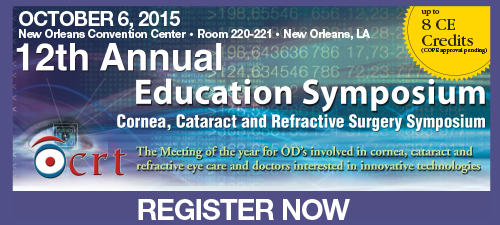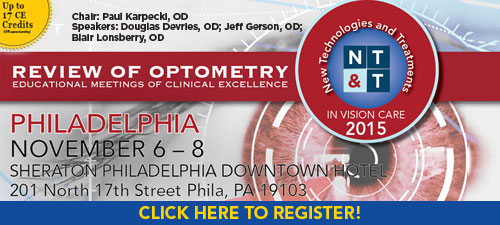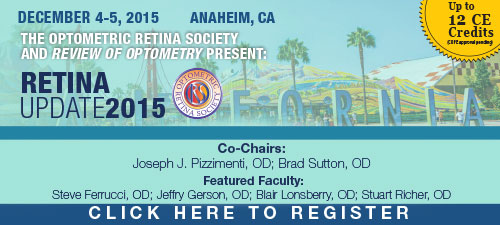
A
weekly e-journal by Art Epstein, OD, FAAO
The Amazing Sullivans
I’ve had the pleasure of highlighting the accomplishments of many individuals. Yet, I’ve never had occasion to acknowledge the accomplishments of an entire family, at least not until now. A few weeks ago I wrote about DEWS-II and TFOS, the Tear Film and Ocular Surface Society (http://www.tearfilm.org/), an organization that has led our understanding of dry eye and ocular surface disease. While truly a collaboration of many, in truth, TFOS likely wouldn’t exist today if not for the Sullivan family. David Sullivan, PhD, who serves as an associate professor at Harvard’s Department of Ophthalmology and a senior scientist at the Schepens Eye Research Institute, has been a driving force behind TFOS since its inception. Of note, David has received the Academy of Optometry’s Carel C. Koch Memorial Medal Award for “outstanding contributions to the enhancement and development of relationships between optometry and other professions.”
|
|||||
 |
||
| Complications and Fitting Challenges Associated with Scleral Contact Lenses | ||||
The modern scleral contact lens (ScCL) has evolved from the very first contact lens fitted 128 years ago. Originally manufactured in glass and oxygen impermeable plastics, these lenses are available today in high Dk gas-permeable materials that allow permeation of oxygen, reducing many of the complications that were seen with older-generation ScCL. However, as with any new contact lens modality, the modern ScCL brings with it a new set of complications and fitting limitations. Researchers conducted Pubmed searches under different keywords to look further into the issue.
Existing literature provides some reports of infection with the scleral devices, although these are often seen in severely compromised corneas, while hypoxic and inflammatory complications are rarely reported in the literature. Furthermore, the somewhat complex relationship of a scleral lens on the eye can create fitting and removal challenges. Anomalies such as conjunctival prolapse, epithelial bogging, midday fogging and limbal bearing have been reported, and appear to be unique sequelae to scleral lens wear. Although this technology broadens the scope in which practitioners can treat patients with irregular ocular surfaces, reports of these complications indicate that there is still a need for continued research to further enhance the clinical outcomes of this promising contact lens modality. |
||||
SOURCE: Walker MK, Bergmanson JP, Miller WL, et al. Complications and fitting challenges associated with scleral contact lenses: A review. Cont Lens Anterior Eye. 2015 Sep 1. [Epub ahead of print]. |
||||

|
||
| Delusional Infestation: Are You Being Bugged? | ||||
This case report documents a 58-year-old male who presented to the clinic with a 12-month history of a burrowing sensation in his eyelids that he attributed to a parasitic infestation. After being extensively investigated and reviewed by relevant specialties, no evidence of parasitic infestation was found. He was diagnosed with and treated for blepharitis. Psychiatric referral for presumed delusional infestation (DI) was recommended. Despite this, he remained insistent in his belief of infestation, and was inevitably lost to follow-up.
DI, previously known as delusional parasitosis, is a rare delusional disorder where affected individuals have a fixed, false belief that they have a parasitic infestation. Diagnosis can be challenging. Practitioners need to evaluate between primary and secondary DI carefully, as management differs depending on the etiology. Despite this, patients diagnosed with primary DI tend to be resistant to psychiatric referral. The report aimed to optimize management by giving the reader a guideline for appropriate investigations and advice on patient approach. Authors stressed the importance of recognizing hallmark features of DI to minimize self-inflicted trauma and associated psychosocial consequences. Effective treatment for DI is available so devastating consequences, including blindness, can be avoided. |
||||
SOURCE: Thakkar A, Ooi KG, Assaad N, Coroneo M. Delusional infestation: are you being bugged? Clin Ophthalmol. 2015;9:967-70. |
||||
| Smartphone-Based Fundus Camera: Imaging the Peripheral Retina | ||||
A fundus camera was designed as a device with slots to fit a smartphone (built-in camera and flash) and 20-D lens to demonstrate an inexpensive smartphone-based fundus camera device (MII Ret Cam) and technique to capture peripheral retinal pictures. With the help of the device and an innovative imaging technique, high-quality fundus videos were taken with easy extraction of images. The MII Ret Cam and imaging technique captured high-quality images of the peripheral retina, such as ora serrata and pars plana, apart from central fundus pictures. Researchers concluded that the smartphone-based fundus camera: can help clinicians monitor diseases affecting both central and peripheral retina; help patients understand their diseases, and clinicians needing to convince their patients of treatment, especially in cases of peripheral lesions; and can be an inexpensive tool for mass screening. |
||||
SOURCE: Sharma A, Subramaniam SD, Ramachandran KI, et al. Smartphone-based fundus camera device (MII Ret Cam) and technique with ability to image peripheral retina. Eur J Ophthalmol. 2015 Aug 5:0. [Epub ahead of print]. |
||||
| News & Notes | ||
| J&J Vison Care Introduces Lens with Tear-infused Design. Johnson & Johnson Vision Care launched Acuvue Oasys Brand Contact Lenses 1-Day with HydraLuxe technology to provide greater comfort and vision throughout an active day. Four key technology advances include: tear-infused material complementing the natural tear film, electrolyte-balanced packaging solution to mimic human tears, enlarged optics to help wearers see clearly even when their pupils may be enlarged due to low-light and increased lens diameter to ensure full corneal limbus coverage during blinking. | ||
| WORLD COUNCIL OF OPTOMETRY ELECTS NEW PRESIDENT. The World Council of Optometry (WCO) announced that Dr. Uduak Udom will take over from Dr. Susan Cooper as president. The announcement was made during the first World Congress of Optometry in August. Dr. Udom is an independent practitioner and world-renowned pioneer in optometry. She was the first optometrist to be awarded the UK Commonwealth Professional Fellowship, first president of Women Optometrists in Nigeria, and first female president of the Nigerian Optometric Association and African Council of Optometry. | ||
| SIGHTRISK CLOUD-BASED ALGORITHM IDENTIFIES AT-RISK AMD PATIENTS.
SightRisk USA, exclusively distributed by MacuHealth, will officially launch its cloud-based algorithm at Vision Expo West in Las Vegas on Sept. 17. SightRisk was developed by a team of research scientists who assessed and documented modifiable lifestyle and non-modifiable risk factors of thousands of subjects diagnosed with age-related macular degeneration (AMD), and reviewed more than 300 published scientific manuscripts. The proprietary algorithm behind the questionnaire compiles and weighs risk factors based on an individual’s answers, creating a unique report eye care professionals can review to identify at-risk profiles that—through consultation and ECP recommendations—may delay or prevent blindness onset resulting from AMD. |
||
| VISION SOURCE, UNITYPOINT HEALTH ANNOUNCE NEW RELATIONSHIP.
North American optometric alliance Vision Source entered into a relationship with UnityPoint Health to improve access to vision and eye health services throughout nine regions in Iowa, Illinois, South Dakota and Wisconsin. Both organizations focus on improving population health outcomes through a collaborative care approach for the patient. Read more. |
||
| CENTERVUE LAUNCHES COMPASS FUNDUS AUTOMATED PERIMETER. CenterVue will announce the U.S. market release of its COMPASS Fundus Automated Perimetry system at Vision Expo West in Las Vegas, following recent FDA 510(k) premarket approval for marketing. COMPASS provides standard 24-2 visual field results and true color confocal images of the retina. Its real-time retinal tracking, acquired at 25 images per second, enables precise monitoring of eye movements during visual field testing with corresponding compensation prior to stimulus projection. An automatic refraction compensation feature eliminates the need for a trial lens correction during testing. |
||
|
Optometric Physician™ (OP) newsletter is owned and published by Dr. Arthur Epstein. It is distributed by the Review Group, a Division of Jobson Medical Information LLC (JMI), 11 Campus Boulevard, Newtown Square, PA 19073. HOW TO ADVERTISE |


